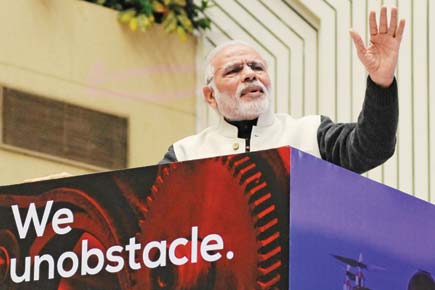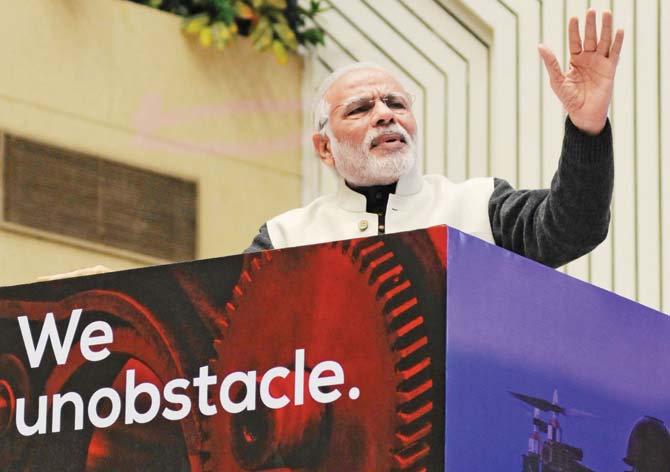Domestic earnings season to be key driver for markets

The New Year has just begun, but the markets are falling continuously. The BSESENSEX lost 479.29 points or 1.92 per cent to close at 24,455.04 points, while NIFTY lost 163.55 points or 2.15 per cent to close at 7,437.80 points. The broader markets lost much more with the BSE100, BSE200 and BSE500 down 2.79 per cent, 3.18 per cent and 3.59 per cent. The readers of this column would recall having been forewarned that valuations in these sectors or stocks have over extended themselves and need to correct.
ADVERTISEMENT

Prime Minister Narendra Modi at the Start-up India Campaign in New Delhi over the weekend. Modi outlined a slew of measures under Start Up India including exempting startups from income tax for their first three years. AFP Photo/STR
Loss season
In sectoral gainers, there was just one in BSEIT up 0.96 per cent led by Infosys, which announced a set of better than expected numbers, and gave some respectability to the falling benchmark indices. The losers were led by BSECAPGOODS down 6.66 per cent and closely followed by BSEPOWER 6.45 per cent and BSEBANKEX 6.16 per cent. BSEREALTY fell 7.76 per cent. In individual stocks, there was no surprise that Infosys was the top gainer, up 7.24 per cent, followed by Reliance Industries, 4.79 per cent. The losers were led by Idea Cellular down 15.42 per cent, followed by BHEL 11.19 per cent. The banking sector was under tremendous pressure, and both, PSU and private banks felt the tremors and heat of the falling market. Canara Bank lost 18.18 per cent, Union Bank 17.07 per cent, Punjab National Bank 12.41 per cent, State Bank of India 11.58 per cent and Bank of Baroda 10.28 per cent. Axis bank was down 9.71 per cent and ICICI Bank 8.33 per cent.
Global pressure
The pressure in markets was global, and Dow Jones lost 358.37 points or 2.19 per cent to close at 15988.08 points. These levels were last seen in August 2015, and the current levels on the SENSEX and NIFTY were last seen in May 2014. The Indian Rupee too was weak, and lost 97 paisa or 1.46 per cent to close at Rs 67.60. FIIs were sellers and domestic institutions were buyers, as is the trend when markets are weak.
The current month NIFTY futures, which expires on January 28, is already down by 500 points or 6.40 per cent. Bears have a complete upper hand and are in total command. The sharp fall over Friday, would see margin calls first thing on Monday and the fact that Dow Jones lost sharply on Friday will not help matters.
Start-ups incentive
The Prime Minister has committed funds to start-ups and announced a fund for the same with some incentives and ease of doing business recognising the need of the hour. The Vice President of the Congress party speaking to students in a Mumbai business college has said that they (Congress) are willing to pass GST provided that some conditions are met.
There is a global crisis currently on and the geo-political issues are adding fuel to the fire. If in such an environment, important bills like GST actually see the light of day, it could be a turning point in the economy.
Hindustan Unilever results were far below expectations and the company has made a surprise announcement of the board approving the transfer of its general reserves to the P&L account for distribution to shareholders.
While this is subject to the permission from regulators, the High Court and shareholders, this would be probably be the first of its kind event. A sum of over R 21,000 crore would be transferred in this manner resulting in a dividend, including tax of around Rs 95-97 per share. While it may sound good, it will take a long time considering the procedures involved and the parent company, which owns 2/3rd of the company, would become the biggest beneficiary.
Recovery time
The results season would continue to be the key domestic driver for markets, while globally it would be China and its reaction from Dow. All indications are that with a weak Dow on Friday night, and margin calls today in India, markets would suffer loses at the open. Thereafter, it would depend on value buying happening or not, for the recovery. The correction in midcap and smallcap has just started, and though there can always be some correction before the fall begins again, it makes sense to only watch that space and not make investments at current levels until valuations become affordable.
Choppy markets would be the order of the day with downward pressure at the beginning. Avoid intraday activity as the volatility hits you adversely and one cannot be sure whose position gets liquidated all of a sudden. The right approach would be to allow markets to settle down and buy on the up tick, rather than trying to pick the bottom.
 Subscribe today by clicking the link and stay updated with the latest news!" Click here!
Subscribe today by clicking the link and stay updated with the latest news!" Click here!






